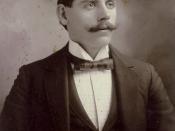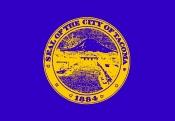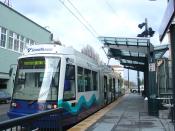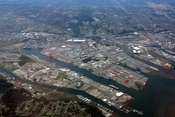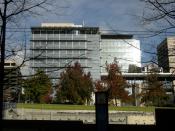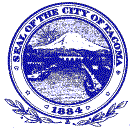There is still a great controversy on who really started The Great Seattle Fire of June 6, 1886. It is said that at 2:45 p.m. that day, a man named John E. Beck accidentally started a fire in the basement of a cabinet shop belonging to Jim McGough. A pot of glue boiled over on the hot stove and set some things on fire. After that, nothing has been the same; Seattle was ironically changed from a town to a city. (James K. Warren) The shop was located at Pontius Block on what is now First Avenue and Madison Street. Five workers were busy filling a stack of orders when the fire initiated. What made it horrifying was that when they tried to subdue the flames by forming a bucket brigade, they fire got away. . (James K. Warren) In those times, they had only 2 ý inch water streams, which was barely enough to control a normal house fire.
Even though the fire was great, no one said it was necessary to call the firemen, but when they did, it was already too late. The fire got out of control, the water supply quickly failed-and within seven hours, Seattle's business district and waterfront were already embers. . (James K. Warren) The water pressure was worse; therefore, they started calling volunteers to help out. They also started sending telegrams to Victoria, Portland and all the larger towns between. Over the fire rose and enormous smoke which could be seen from Tacoma. The fire was traveling north rapidly with the wind. . (James K. Warren) The fire swept to a lot of streets, it was put to a halt by the railroad trestles, but it wasn't certain. The fire continued to seize until there was no other brick building left unburned in the business district. Some small frame structures in the same block south of it were destroyed. . (James K. Warren) It was then about 6 o'clock when the fire still was raging through the city. By then, the Tacoma firemen arrived. At the date, there was no engine in Tacoma so they brought only a hose carriage and hose, which were of little use after the water pressure failed. In one of the buildings, there was a major explosion which caused the fire to grow quicker and forced inmates to run for their lives. . (James K. Warren) There was no time to save goods and not very much to save life; by 9:30 it had smothered everything there was left to burn. It stopped because of lack of material. The fire covered 116 acres, which was the most valuable part of the town. Nothing but broken walls remained of the town's business stores. (James K. Warren) The people of Tacoma played a big role in helping fellow citizens of Seattle. They provided food and supplies for the needy. Great tents for the homeless were set up the next day, and the ladies' relief organizations saw to it that no one went hungry.
"The published list of losses footed up an adding machine total of $7,179,725 and adding $1,100,00 which is an estimated figure for the losses of the City of Seattle in streets, docks, etc., makes $8,279,725. There is no mention in the lists of the Water Company or the Electric Light Co. for their losses on their mains, wires, and poles in the burned district. On the strength of the value of personal effects in lodge houses and hotels, added to the foregoing figures, the total loss has been placed as high as $20,000,000, but this is out of all reasonâ¦" (Page 119-Brad Arthur) "The dawn of June 7 marked the birth of a new Seattle. With the first light, the ruin-lined streets were full of animation. The city did not give itself time to cool off. Its people were ready and anxious for the task of reconstruction." (Page 119- Brad Arthur) The people of the stricken city met in Armory Hall to plan immediate reconstruction. Mayor Robert announced and there were 600 citizens involved with the plan. All were active businessmen. The city brought its strongest fighting men to face the crisis just like any other. Tacoma offered aid and as soon as other cities herd about it, they also started contributing. Tacoma raised $10,000 cash in one hour, San Francisco sent $10,000 cash, Olympia $1,000, Virginia City $4,000, and other towns accordingly.
"On the 12th, 200 men were set to work with teams to clear the streets of debris in the burned district. Al l workmen were given employment at once at good wages to build up 'New Seattle.' (Brad Arthur) "For the first twenty days after the fire more than forty-one thousand meals were served in the Tacoma relief tent. Tacoma's extraordinary relief work did a great deal to heal the breach that existed between the two cities.' No matter what the future Puget Sound, Seattle should never forget that in the hour of her direst need Tacoma stood nobly by her, fed her people and gave as bountifully of her money as her food." (Welford Beaton, in The City That Made Itself) Seattle received a total cash contribution of $98,805.
The public schools, which had closed temporarily, were reopened on Monday, June 10th. Fortunately, no one got hurt from the fire, but it was reported that 1 million rats were consumed in the flames. Pg.120 (Brad Arthur) Seattle began to rebuild itself so quickly that it grew fame over the country. Nothing like it had been witnessed on the American continent with the single exception of Chicago during the period immediately succeeding the great fire of 1871. Within a year the population jumped from 25,000 to 43,000. It can be said on the bright side that the fire didn't hurt Seattle a lot but gained confidence in those who wished to have a better city and be known a little bit more around the country. Seattle become more united, the people worked hard along with some help from other cities to rebuild itself. A new city was born. (Pg.120- Brad Arthur)
